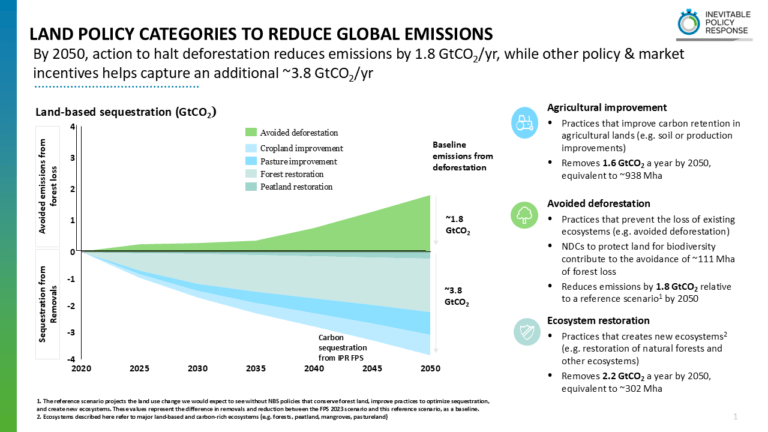- IPR Intelligence
- Back to Main Page
Report Summary – Brazil can show the way for scaling Nature Based Solutions at COP30 – Latest Briefing Paper from IPR, in collaboration with Kaya Partners.
Brazil has the potential to attract adequate capital, which, if strategically designed and promptly deployed, could significantly advance towards achieving NBS goals by 2050. However, achieving 2030 goals for both Brazil and the world is more of a challenge, and global mobilization for 2050 remains uncertain.
Summary:
- The 2025 COP 30 will be held in Brazil and is certain to focus attention on Nature.
- Nature-based solutions (NBS) to reduce CO2 emissions arising from the agriculture and land sectors will play a critical role in temperature stabilization this century. The Inevitable Policy Response Forecast Policy Scenario (IPR FPS) forecasts NBS, encompassing sustainable agriculture, ending deforestation and land conversion, and afforestation in a biodiverse manner, could help reduce global GHG emissions down to ~11.59 GtCO2e in 2050 (in total, a 77% drop from current levels).
These NBS solutions help drive existing land CO2 emissions from over 3 GtCO2 today to net negative in 2050 (-3.5 GtCO2), contributing 20% to GHG emissions reductions in 2050. In the nearer term, IPR forecasts land CO2 emissions halving to ~1.4 Gt by 2030.
- Global NBS deployment today is far from the scale suggested by ambitious climate scenarios. 2030-2035 is a critical inflection point when global deforestation must end and solutions to sequester carbon need to already be delivering at pace.
In 2023 IPR forecasted that globally these NBS can deliver 2 GtCO2 mitigation per year by 2030, growing to 5.6 GtCO2/yr by 2050. Sub-Saharan Africa, China, Brazil and Southeast Asia are key countries for NBS delivery (estimated at 30% of total abatement) due to their size and greater sequestration potential of their forests.
- Realizing the climate benefits from NBS will require significant uplift in investment and soon. IPR FPS 2023 estimates $354 billion in cumulative investment by 2030, rising to $1.6 trillion in cumulative investment by 2050, is needed to deliver the 5.6GtCO2 of mitigation per year. This implies annual global investment of $36bn by 2030, growing to $75bn per year by 2050.
- The replicability, scalability and near-term impact of existing instruments to scale NBS including compliance and voluntary markets remain uncertain and it is critical that other mechanisms be activated over the next five years. Voluntary and carbon markets could grow but despite decades of deployment these have not mobilized finance at sufficient scale.
- Biodiversity is a key adjunct. NBS needs to be biodiverse and the push to maintain biodiversity helps NBS. High quality NBS projects implemented appropriately can support relatively higher levels of biodiversity, for example, afforestation using a natural mix of trees rather than monoculture can produce more positive nature outcomes.
- Brazil has massive potential to scale NBS. Brazil represents 10% of global NBS mitigation in IPR FPS 2023 and will need cumulative investment of $56bn by 2030, about 16% of global NBS spend, growing to $138bn in cumulative investment by 2050, to deliver these CO2 reductions.
- IPR analysis suggests Brazil could succeed in shoring up needed investment levels for climate in the longer term, offering a potential model for the globe. Private sector funding has started flowing and is crucial in whether by 2030 funding requirements are met, rural credit schemes are expanding, and a compliance carbon market is advancing through the Brazilian Congress.
However, private capital flows are currently low due limited track record and high perceived risk of these investments. A scaling up of concessional finance and catalytic capital will be key to accelerate private finance.
- At the global level, successful delivery of NBS in both the near (2030) and long term (2050) remains uncertain. As the host of COP30 in the Amazon, Brazil is again offering a promising alternative private sector funded model for protecting all tropical forests. Introduced at COP28, a Tropical Forests Forever Facility (TFFF) would pay tropical countries per hectare of forest they maintain, funded by governments, private companies and financial institutions.
The TFFF would be a fund of funds taking 20-year deposits in return for fixed low interest rates, with deposits invested and returns allocated to tropical forest countries and partially to investors. If properly designed, it could be another key element for NBS funding.
- If the current public/private initiatives fail to mobilize the $1.6 trillion needed globally by 2050, other large-scale government-to-government funds modelled after the Amazon Fund will need to intervene if the world and is to stabilize climate and nature. China will likely achieve its NBS potential, and Brazil is making notable progress. Southeast Asia could enhance existing initiatives or replicate Brazil’s strategies. Government-to-government funding may therefore be most needed in large developing regions such as Sub-Saharan Africa due to its extensive land area, growing population, and advancing agricultural economy.
Although delays could jeopardize the nearer term objectives, substantial scaling efforts into the 2030s would help close the gap. This presents a significant risk but may be unavoidable. The outcome of COP30 will be crucial in addressing this land challenge.
IPR will revisit its land forecasts this year with the potential of downgrading its nearer term policy forecasts for land and nature in its Annual Review in early 2025.
- This November’s COP29 negotiations on a New Collective Quantified Goal (NCQG) for climate finance could create a robust framework to support scaling of NBS worldwide. This captures both public and private initiatives.
Ambitious financial commitments will demonstrate seriousness of international commitment, in turn encouraging counties with significant potential to prioritize NBS in their policies, strategies and budgets.
Download the full IPR / Kaya Partners Briefing here: (Link) (estimated at 30% of total abatement) due to their size and greater sequestration potential of their forests.

